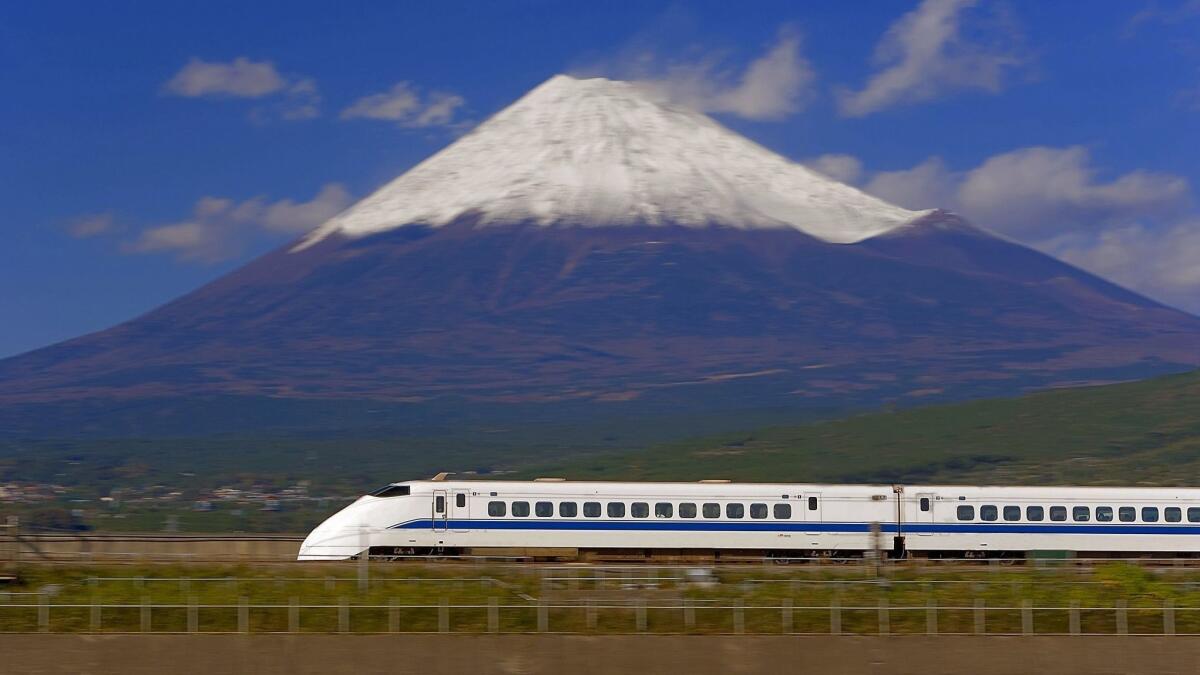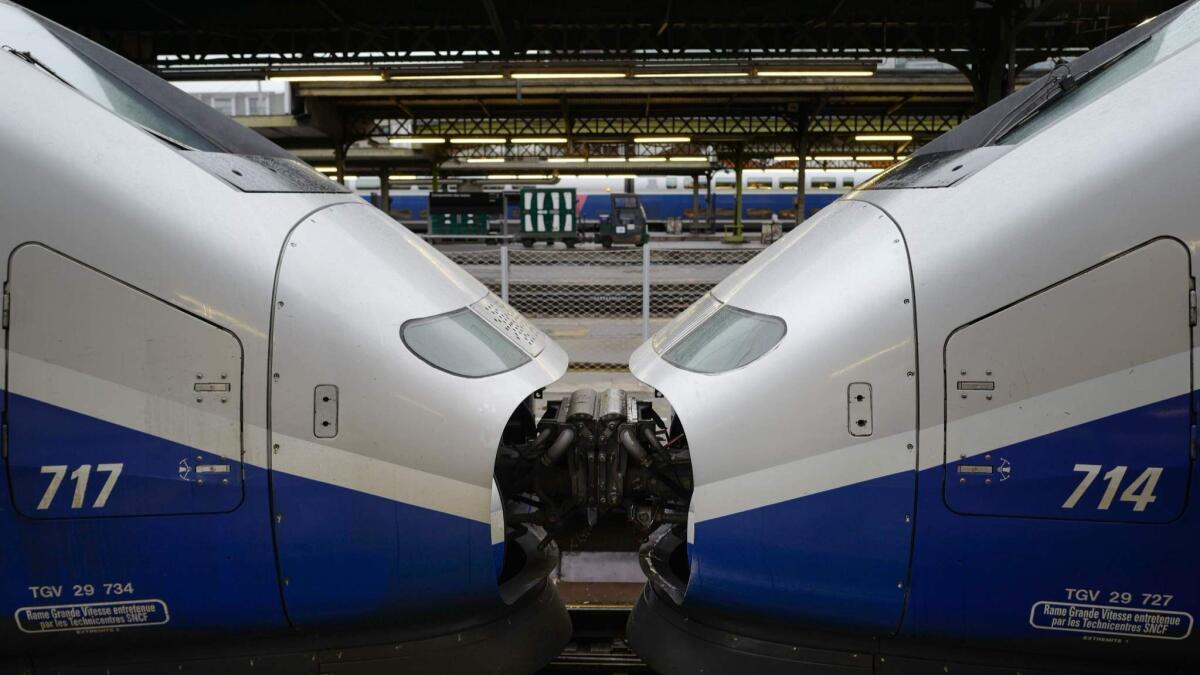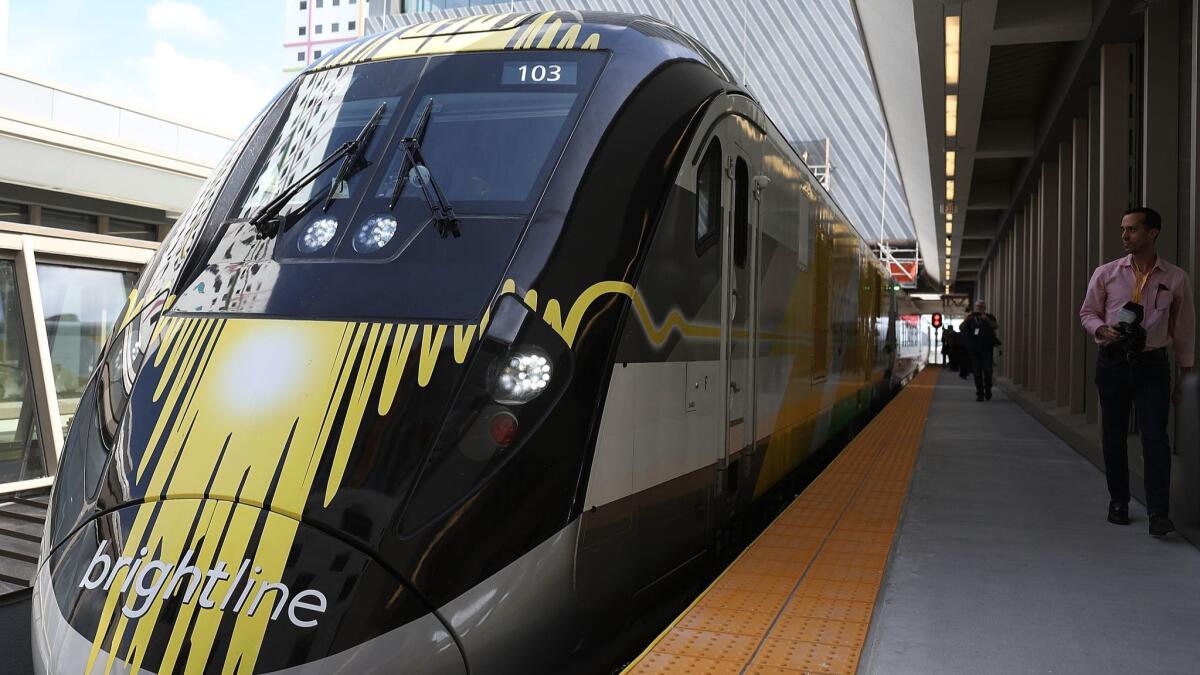Calculations show bullet train can complete route within 2 hours and 40 minutes. Reality may prove slower
- Share via
When California voters approved construction of a bullet train in 2008, they had a legal promise that passengers would be able to speed from Los Angeles to San Francisco in two hours and 40 minutes.
But over the next decade, the state rail authority made a series of political and financial compromises that slowed speeds on long stretches of the track.
The authority says it can still meet its trip time commitments, though not by much.
Computer simulations conducted earlier this year by the authority, obtained by The Times under a public records act request, show the bullet train is three minutes and 10 seconds inside the legal mandate.
Such a tight margin of error has some disputing whether the rail network will regularly hit that two-hour-40 minute time, in part because the assumptions that went into those simulations are highly optimistic and unproven. The premise hinges on trains operating at higher speeds than virtually all the systems in Asia and Europe; human train operators consistently performing with the precision of a computer model; favorable deals on the use of tracks that the state doesn’t even own; and amicable decisions by federal safety regulators.
Frank Vacca, chief of rail operations for the California High-Speed Rail Authority, says the system will be “fully compliant” with the law and able to make the trip within the time limit in regular operations.
Speed is critical to the project — not just because of the legal mandate. Fast trains will directly affect ridership and whether the operation can generate enough revenue to avoid red ink that must be covered by government subsidies.
But speed doesn’t come cheap. Faster trains require costly longer tunnels and more viaducts. The current price tag is $77 billion, up from $33 billion when the project was approved.
Funding has become a problem for the rail authority, which can’t afford to complete even a partial operational segment — slow or fast. In its 2018 business plan, the authority deleted construction of a 13-mile tunnel under the Pacheco Pass from its first phase because it did not have enough money. The decision will leave about 80 miles of track in the Bay Area disconnected from 119 miles of track in the Central Valley.
State law does not give the project much room to maneuver.
The 2008 bond act approved by voters said the system had to be “designed to achieve” a trip time of two hours and 40 minutes. Rail authority officials have long contended that the legal fine print does not require them to actually operate trains on such a schedule. The interpretation raises the prospect that the state is spending billions of dollars on a capability it will never use.
“If they don’t get two hours and 40 minutes, they are not going to get the predicted benefits of this very expensive system,” said Daniel Brand, a retired ridership expert with Charles River Associates who conducted the early passenger studies for the project in the 1990s.
Vacca says it nonetheless makes sense: “You can have a car designed to go 150 miles per hour, but you don’t drive that fast.”
By international standards, the California timetable is audacious.
The Japanese Shinkansen, the inspiration for all of the world’s high speed trains, operates between Tokyo and Osaka, a distance of 344 miles. The fastest trip takes two hours and 22 minutes, yielding an average speed of 145 miles per hour, according to Japanese Railway schedules.
The French Train à Grande Vitesse, or TGV, operates the Paris to Lyon line over 243 miles and takes one hour and 59 minutes, according to TGV schedules. The average speed is 121 miles per hour.
But the Los Angeles to San Francisco route, which would traverse three mountain ranges and five of the 10 largest cities in the state, is supposed to travel 438 miles in 2 hours and 40 minutes — requiring an average speed of 164 miles per hour.

When the rail authority solicited international firms to help build and finance the system, the Spanish firm Sacyr Concesiones S.L., which has helped build 40 bullet train projects around the world, warned the state in a 2015 report that its speeds would push up costs.
“One of the main cost drivers is the requirement of 220 mph operating speed,” the firm wrote. “220 mph is higher than most if not all standard commercial speed for HSR, since it goes beyond the operating speed of similar HSR currently operating anywhere in the world. Due to the high-tech nature of the system infrastructure, operation and maintenance costs also grow exponentially.”
One fundamental problem for the California system is that it’s at the upper end of the distance where bullet trains can compete effectively with airlines, so it has to be as fast as possible.
Top speeds require precise track alignment — straight and level. A curve that allows a train to operate at the max speed of 220 mph would have a circumference of more than 50 miles, were it to make a complete circle. Going over mountains requires deep tunnels to level out the climb so that the grades are half as steep as those on interstate freeways.
Quentin Kopp, then chairman of the rail authority when the speed requirements were created in 2008, said the legislature erred in trying to dictate train speeds.
“It does not make sense to run at these speeds given the cost, but it is too late to change,” said Kopp, a plaintiff in a suit alleging the state is violating the bond act. “You would have to go back to voters and they would turn it down as a way of stopping the project.”
Former California Treasurer William Lockyer, who was chief of the state Senate in 2008 and remains a supporter, has a similar opinion.
“These details of trip times may have been too specific, but that is easy to say now,” he said.
The speed mandate was created by a small group of political staffers and bureaucrats huddled in a Senate conference room in spring 2008. They believed guaranteeing high speeds was critical to the future success of the system and to convince voters to back a $9-billion bond later that year.
The main proponent of mandating the trip times was Mehdi Morshed, the longtime chief executive of the rail authority who believes rail speeds would be endlessly compromised were they not backed up by law.
“I am the one who insisted on putting the times in,” he said. “The purpose of the high speed train was to get people places fast. High speed doesn’t mean much if you don’t put in the law that you will have to get from one place to another in a certain amount of time.”
The law, however, has in some cases failed to prevent the kinds of compromises Morshed feared.
In 2011, the rail authority faced growing opposition in wealthy Silicon Valley communities about an elevated viaduct that would carry 220-mph trains. In a deal with Bay Area elected officials, the state agreed to put the bullet train on ground-level tracks shared with much slower commuter trains between San Jose and San Francisco. A similar compromise was later made between Burbank and Los Angeles. The deals not only quelled opposition but helped reduce costs by billions of dollars.
In 2016, the rail authority cut costs by reducing the planned diameter of roughly 50 miles of mountain tunnels, which reduced speeds to a maximum of 200 mph. And earlier this year, the rail authority gave up plans for dedicated tracks over 30 miles from Gilroy to San Jose, saying it would attempt to build track on a freight right of way that would limit speeds to 110 mph.
Many transportation experts, including state staff and independent analysts, have long dismissed the probability that any operational California bullet train will meet the two-hour-40 minute timetable. A state-appointed peer review panel warned the legislature in 2013 that “it is unlikely that trains would actually be scheduled to run during normal hours of operation within … 2 hours 40 minute limits.”
Brand, the retired ridership expert, has similar concerns, saying, “It is not that they could never achieve it, but it would be very difficult to do.”

The computer simulations that are supposed to prove the validity of the trip times are based on a lot of hope.
One key assumption is that trains will move through the urban Bay Area and Los Angeles nonstop, even while sharing track with trains that make multiple stops at stations along the way.
It would involve using parallel tracks, which only exist along limited segments of rail, to bypass commuter trains, Vacca said. During rush hour, the puzzle would require as many as four bullet trains to weave around six commuter trains per hour while relying on a sophisticated new signaling system.
Caltrain commuter trains in the Bay Area may have to sit idle for up to seven minutes while bullet trains pass by, according to a 2016 rail authority planning document prepared by a Swiss consultant. Caltrain officials said there is no agreement on such future movements on the track, which Caltrain owns.
The trains would also have to sail through Fresno, Bakersfield, Palmdale and other communities at 220 miles per hour, speeds that have triggered a public backlash in Europe, said Lisa Schweitzer, a USC professor who specializes in transportation.
“I can’t imagine most communities would agree to trains operating at these speeds,” she said.
Vacca said any noise or vibration impacts on communities would be mitigated with such features as sound walls to reduce noise.
Another key assumption is that trains on shared track would get federal approval to pass through at-grade crossings in dense urban areas at 110 mph, requiring sophisticated crossing gates to prevent crashes. While there are a few areas on the Amtrak’s Acela service along the East Coast that have such speeds, they are in rural areas.
The rail authority has a plan to straighten out track and add passing tracks in the phases through Silicon Valley. Until those improvements are completed, trains would operate at 79 mph, Vacca said. Some day, the authority has hopes of even going 125 mph through the area.
“It is possible to do 110 mph on some of the [highway] crossings, but it is a real challenge on the Caltrain corridor,” said Grady Cothen, a former Federal Railroad Administration safety chief and attorney.
“There are no safety issues,” Vacca, formerly Amtrak’s chief engineer, said. “I see no reason why we can’t.”
The computer simulations also assumed that trains would stop and start in San Francisco at a station located at 4th and King streets, rather than the downtown Transbay terminal identified in the bond act as terminus of the system. The authority would need to dig a curvy 1.3-mile train tunnel under the city to reach Transbay. Vacca noted that the bond act does not specifically say the trip must go to Transbay.
Through the years, the train authority has remained committed to competing with airlines. By 2040, it projects bullet trains will carry 40 million passengers, including 5 million captured from airlines and 32 million from cars.
Robert Poole, a transportation expert at Reason Foundation, a libertarian nonprofit, said competing with airlines in California will be fraught with risk, since so many potential travelers live closer to airports than the future train stations and the air market is so highly developed.
Poole notes that Florida is building its Brightline passenger rail system, which will be operational from Miami to Orlando by 2021, at much lower cost with 79 mph to 125 mph speeds. The aim is to divert motorists from crowded highways.
“It is a very clever design,” he said. “They figured three hours from Miami to Orlando was good enough.”

Follow me on Twitter @rvartabedian
More to Read
Sign up for Essential California
The most important California stories and recommendations in your inbox every morning.
You may occasionally receive promotional content from the Los Angeles Times.











